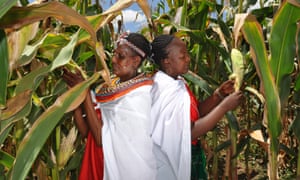On Kenya's climate frontline, female farmers are building a secure future
On a slope overlooking the rugged land of dry shrubs around Lolmusikopyi village in Kenya’s Samburu county, Christine Letooya is busy harvesting her crop.
Letooya plucks the ripe cobs of maize from between the papery leaves. Like all farmers, she works long hours but at least this toil is safe – she used to be a pastoralist but armed raids by cattle rustlers persuaded the mother of four to change her way of life.
“Five years ago, our village was raided by armed young men from the Pokot community. They made away with our herds, leaving us at the mercy of relief aid. We had to relocate to safer grounds,” says Letooya, who is wearing a traditional Samburu necklace of coloured beads.
With the help of charity World Vision, Letooya decided to embark on sustainable farming through a project to support farmers in this notoriously harsh terrain with seeds and training. Now in its third year, the scheme offers alternative livelihoods to Samburu, helps to combat malnutrition, and equips local people to cope with more frequent droughts.
It’s a problem that dogs the arid land of Samburu county. In 2011, this region, and neighbouring areas of northern Kenya, Ethiopia and Somalia, was hard hit by the drought in the Horn of Africa. Millions of people were plunged into crisis, and tens of thousands died.
As global warming increases the frequency of extreme weather events, such as droughts and floods, Samburu – where life has always been hard and the environment fickle – is on a climate frontline that runs through northern Kenya.
In a report last month, Human Rights Watch warned that climate change, as well as regional development projects, were threatening the health and livelihoods ofindigenous people in the neighbouring Turkana region.
Kenya has joined a group of the 20 countries most vulnerable to climate change – the vulnerable twenty or V20 – to mobilise climate funds and develop and share best practices in shoring up national defences. This comes ahead of the UN climate change conference in Paris from 30 November to 11 December, when world leaders will aim to hammer out a deal to curb the rise in global temperatures.
Meanwhile, in Samburu, small but significant steps are being taken to help people become more resilient in the face of shifting weather patterns.
“We used to trek about 10km to attend training run by government agricultural officers. It was not efficient,” said Beatrice Nantei Lesukuta. “But since World Vision brought the training services to our doorstep, we have seen a difference.”
Lesukuta, 36, is secretary for the 36-member Lolkunono Women’s Group of former pastoralists who have embraced farming. The women are allocated communal land by their husbands, or by community elders.
Christine Lenyasunya, a 40-year-old widow, lost more than 100 animals when raiders attacked Lesidai village five years ago, maiming and killing people.
“We moved to Lolkunono after the raid. Since I joined Lolkunono Women’s Group, life has never been the same,” she said. Lenyasunya recently harvested beans from her five-acre farm, and is waiting for her maize crop, while also growing kale and pumpkins.
The farming project also works on improving diets. This year’s global nutrition report showed Kenya was the only country on course to meet all five World Health Assembly maternal and child nutrition targets. But 35% of children under the age of five – nearly 2.5 million – are stunted: too short for their age, and may not to reach their full development potential.
We empower women from vulnerable communities across Kenya, since if we empower women, they will take care of their families,” said World Vision’s country director, Dickens Thunde. “It is not easy to sustain livelihoods in conditions like this, where the communities – particularly the pastoralists – do not know when to expect the next rainfall.”
The World Vision project is part of theEU-funded Samburu Pastoral Livelihoods Improvement Programme (SAPLIP), which aims to mitigate the effects of climate change, and tackle the resulting food insecurity. The initiative includes training on how to regenerate indigenous trees and shrubs.
The €2.1m ($2.26m) scheme has also led to the creation of six water pans, which are used to harvest rainwater and support around 3,000 households and more than 25,000 animals.
In September, the EU commmissioner for international cooperation and development, Neven Mimica, visited Samburu as part of his first official trip to east Africa.
Arid and semi-arid lands are becoming increasingly vulnerable, especially due to climate change. Food security, resilience, and better nutrition in arid areas are therefore key priorities for the EU development cooperation agenda in the next few years here in Kenya,” he said.
Mimica also announced that nine counties, including Samburu, would participate in a four-year, €19m EU maternal and child nutrition plan, which is part of a wider programme to support resilience among communities in the Horn of Africa.
Back in Samburu, the women’s new roles have also improved their status in a traditionally patriarchal society, where their primary role had been to look after children.
“Most of our members used to rely on our husbands, even for needs such as clothing,” said Letooya, who recently sold four bags of maize to pay school fees for her son. “With farming, now I can buy anything of my choice, have my children decently clothed and buy food for my family.


No comments:
Post a Comment